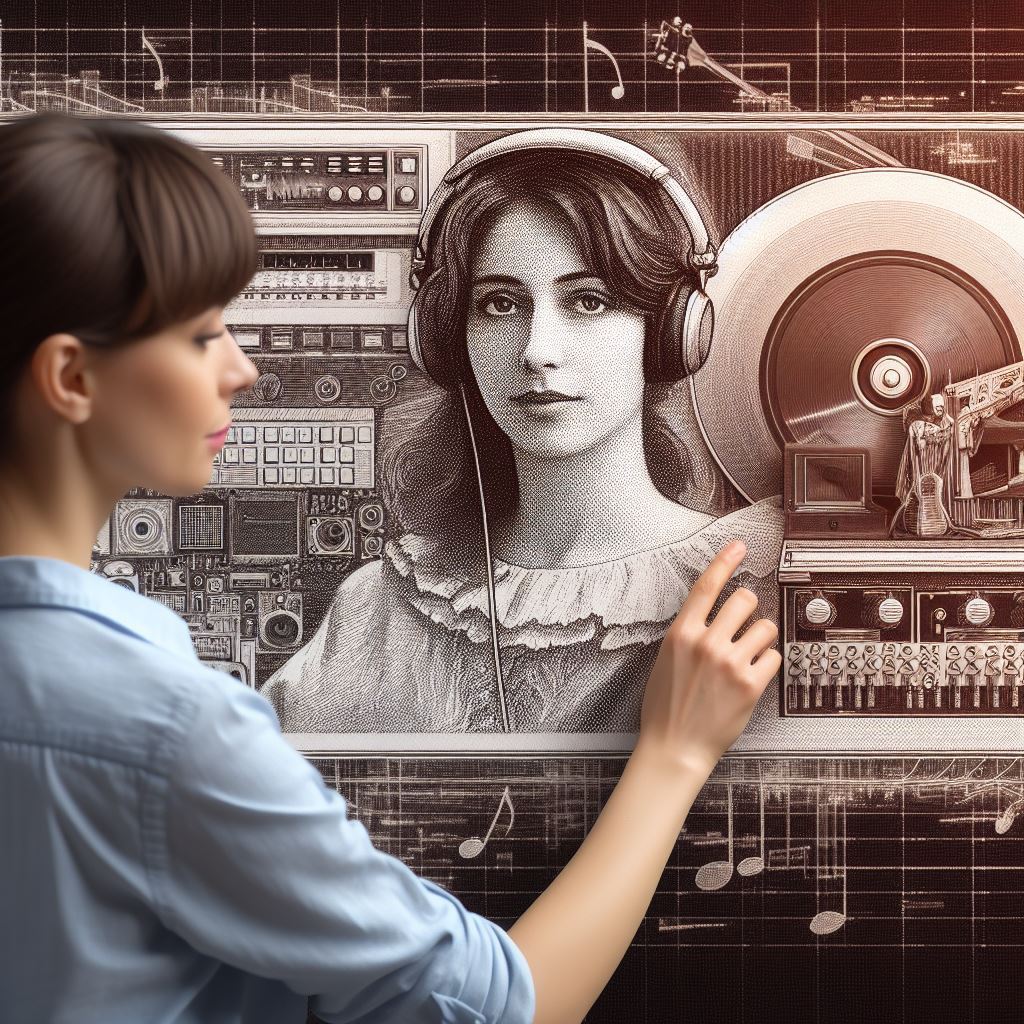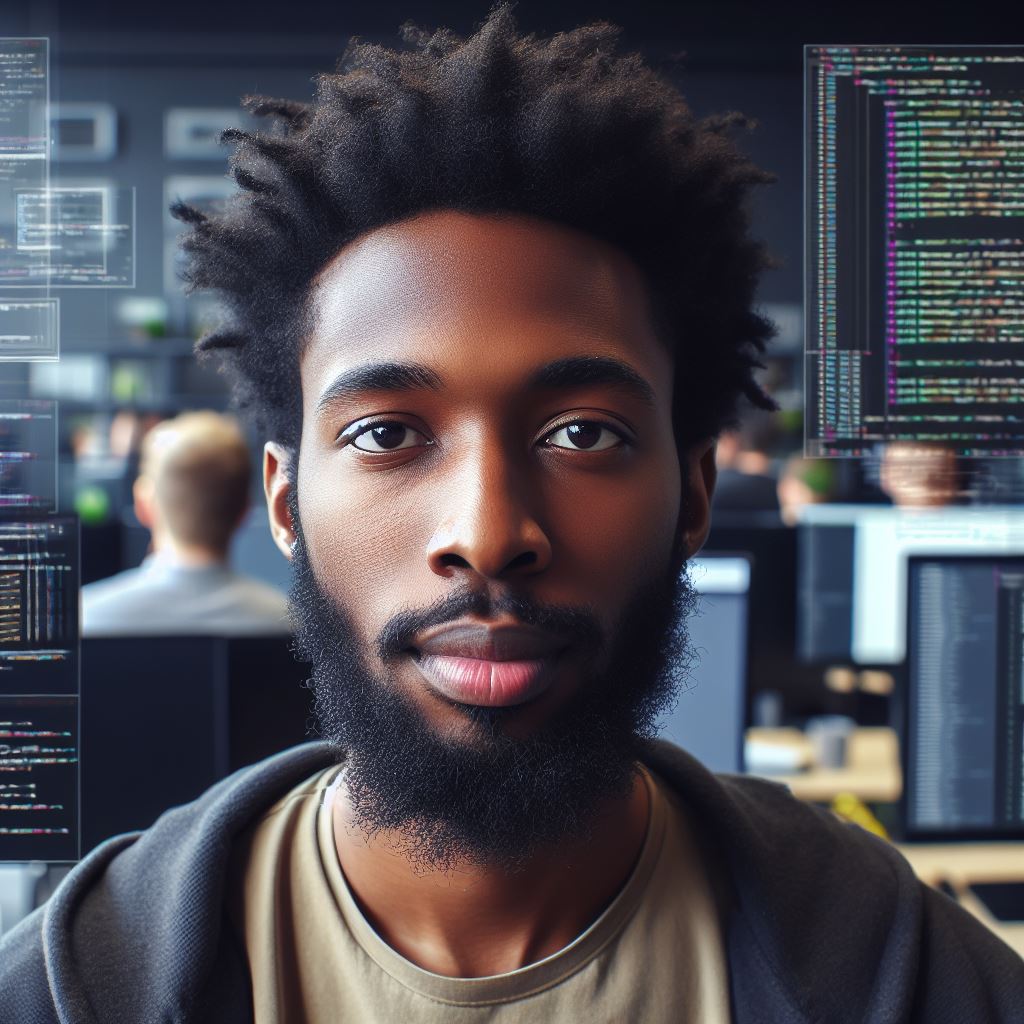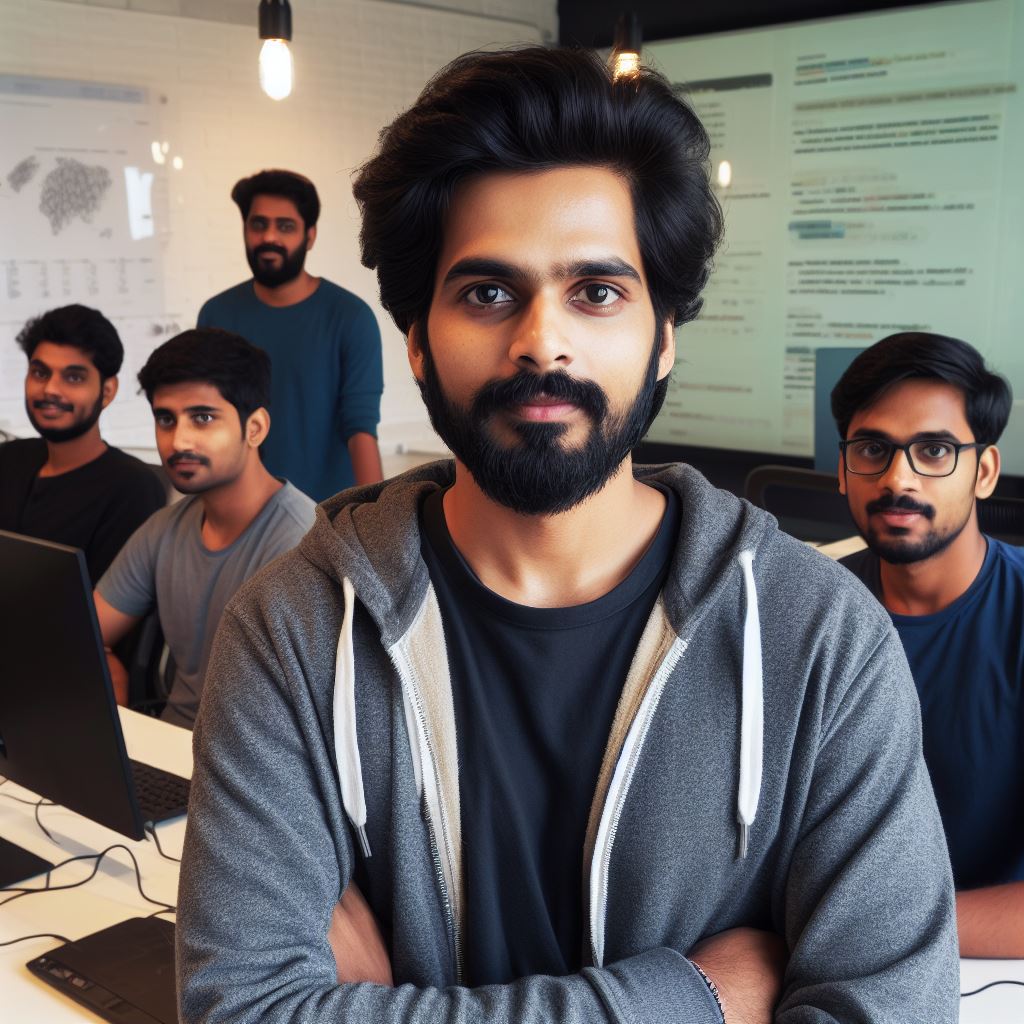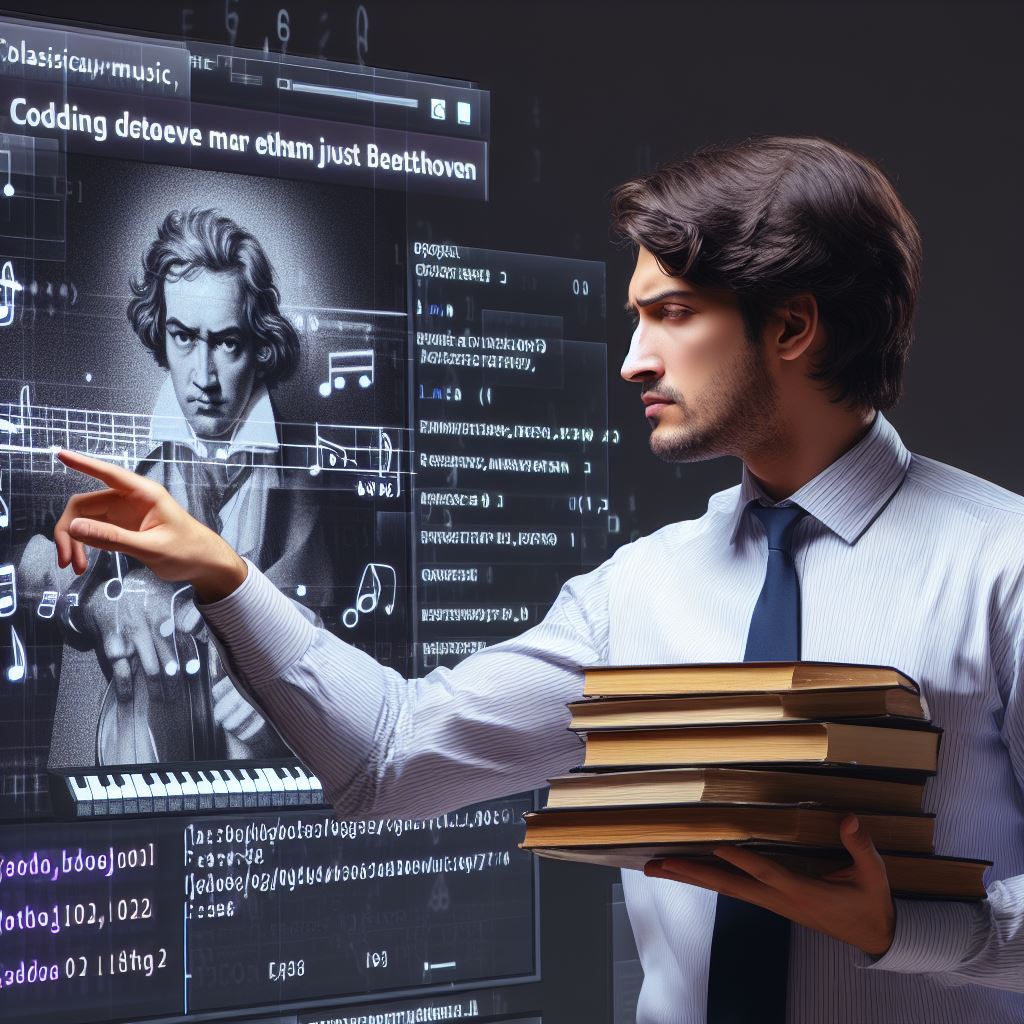Introduction
Music and coding share an intriguing connection that has fascinated many over the years. This text explores the historical significance and evolution of music in the coding world.
- The story began with the emergence of computer programming, revealing the potential for creating musical compositions through code.
- Early attempts featured simple melodies, but technological advancements paved the way for more complex music creation.
- The introduction of MIDI in the 1980s marked a turning point, enabling precise control of musical instruments through coding.
- Today, music and coding continue to evolve, with innovative technologies expanding creative possibilities.
- From algorithmic composition to generative music, coding has become integral to modern music creation.
- This historical journey highlights the captivating interplay between music and coding, transforming music’s creation and experience.
- As technology advances, the future of music in the coding world promises even more exciting developments.
Music in Early Computer Programming
The Use of Sound in Early Computer Programming
In the early days of computer programming, sound was not a common feature.
Programmers primarily focused on creating functionality and algorithms, with little emphasis on incorporating audio elements into their work.
However, some early pioneers recognized the potential of using sound as a creative and interactive element within computer programming.
For instance, Ada Lovelace, an English mathematician and writer, envisioned the possibility of creating music using Charles Babbage’s Analytical Engine in the early 19th century.
Lovelace’s notes on the machine included a way to generate musical compositions, making her one of the first to pioneer the idea of music in coding.
Decades later, Alan Turing, a British mathematician and computer scientist, made significant contributions to the field of computer programming.
Although he is best known for his code-breaking efforts during World War II, Turing was also interested in the intersection of computers and music.
Throughout his career, Turing explored the idea of creating music with computers and even wrote algorithms for generating musical notes. His work laid the foundation for future advancements in music and coding.
Pioneering Efforts by Ada Lovelace and Alan Turing
Ada Lovelace’s work on the Analytical Engine and her ideas about generating music through code showcased her visionary thinking and creativity.
Lovelace’s notes, written in the mid-1800s, described a method for programming the Analytical Engine to produce not only numerical calculations but also music.
Her contributions laid the groundwork for incorporating sound into computer programming, even before computers existed in their modern form.
Alan Turing, on the other hand, explored the potential of creating music using codes and algorithms.
His algorithms, known as Turing music, focused on generating musical notes through mathematical calculations.
Turing’s efforts demonstrated that music and coding could be intertwined, and his exploration paved the way for future innovations in computer-generated music.
Tech Consulting Tailored to Your Coding Journey
Get expert guidance in coding with a personalized consultation. Receive unique, actionable insights delivered in 1-3 business days.
Get StartedLimitations and Challenges of the Era
During this era, programming was a tedious and time-consuming process. Computers were also limited in their capabilities, which presented challenges for incorporating sound.
Due to hardware limitations, generating and playing music on early computers was a complex task.
Sound capabilities were often limited to basic beeps and tones, creating significant challenges for programmers attempting to create more complex and realistic musical compositions.
Additionally, the lack of standardized coding languages and platforms made it difficult for programmers to exchange and share music-related code.
Each computer system had its own unique coding requirements, further hindering the development of music in the coding world.
Despite these challenges, Ada Lovelace and Alan Turing, along with other early pioneers, showed that music could be a valuable part of computer programming.
Their groundbreaking efforts laid the foundation for future innovations that would bring music and coding closer together.
Overall, the early days of computer programming saw limited use of sound, but visionary figures like Ada Lovelace and Alan Turing recognized the potential of incorporating music into code.
Their pioneering efforts and the challenges they faced set the stage for the next chapter in the history of music in the coding world.
Read: VBA Error Handling: Best Practices for Excel
The Rise of Game Music
The Emergence of Video Game Soundtracks in the 1970s and 1980s
- Video game soundtracks first gained prominence in the 1970s and 1980s.
- Early games like Pong and Space Invaders relied on simple beeps and boops for sound effects.
- As game technology advanced, composers started creating more intricate music for the games.
- In 1978, Taito’s game “Space Invaders” featured a repetitive, yet iconic, soundtrack that captured players’ attention.
- The success of “Space Invaders” paved the way for future game soundtracks to be taken more seriously.
The Influence of Game Music on Coding Practices
- Game music played a significant role in shaping coding practices in the early days.
- Composers had to work within the limited hardware capabilities of consoles and computers.
- This forced them to be creative and find innovative ways to create memorable melodies with limited resources.
- As a result, coding practices in the gaming industry became more efficient and optimized.
- Game composers pioneered techniques like sound synthesis and music streaming to create immersive experiences.
Notable Game Music Composers and Their Contributions
- Koji Kondo: Known for composing the iconic music of Super Mario Bros., The Legend of Zelda, and many other Nintendo games.
- Nobuo Uematsu: Famous for his work on the Final Fantasy series, Uematsu’s compositions revolutionized game music.
- Yoko Shimomura: Known for her work on the Street Fighter II and Kingdom Hearts series, Shimomura’s music brought games to life.
- Jeremy Soule: Composed the memorable soundtracks for The Elder Scrolls series, immersing players in the fantasy worlds.
- Austin Wintory: His compositions for games like Journey pushed the boundaries of game music, earning critical acclaim.
Overall, the rise of game music in the 1970s and 1980s had a profound impact on the coding world.
From the early simple beeps and boops to the complex and immersive soundtracks of today, game music has come a long way.
Composers pushed the boundaries of what was possible with limited resources, influencing coding practices in the process.
Notable composers like Koji Kondo, Nobuo Uematsu, Yoko Shimomura, Jeremy Soule, and Austin Wintory have left a lasting legacy in the gaming industry.
Build Your Vision, Perfectly Tailored
Get a custom-built website or application that matches your vision and needs. Stand out from the crowd with a solution designed just for you—professional, scalable, and seamless.
Get StartedTheir contributions have made game music an integral part of the gaming experience, captivating players and enhancing gameplay.
Read: Excel Pivot Tables: Coding Techniques You Should Know
The Birth of Chiptunes
Explaining the Concept of Chiptunes and their Relation to Coding
Chiptunes, also known as chip music or 8-bit music, are synthesized electronic music made using sound chips.
They emerged alongside the rise of early video game consoles and computers in the 1980s.
These sound chips were originally designed to produce basic sound effects and music for games.
However, creative programmers and musicians quickly realized the potential for creating intricate music using these chips.
By manipulating the registers and channels of the sound chips through coding, they could compose complex melodies, harmonies, and rhythms.
Thus, chiptunes became a unique form of music that directly combined coding techniques with musical composition.
Discussing the Use of Specialized Sound Chips in Early Game Consoles and Computers
Early game consoles and computers featured specialized sound chips, such as the Commodore 64’s SID chip and the Nintendo Entertainment System’s (NES) Ricoh 2A03 chip.
These chips had limited capabilities, compared to modern music synthesizers, but they allowed for distinct and recognizable sounds.
Programmers had to work within the limitations of these chips to create music, often relying on techniques like pulse width modulation and frequency modulation to generate different tones and sounds.
Despite the constraints, talented musicians managed to push the boundaries, producing captivating chiptune compositions that became an integral part of many gaming experiences.
Highlighting the Demoscene Culture and Its Impact on Chiptunes
The demoscene culture played a significant role in popularizing chiptunes and pushing the boundaries of what could be achieved with sound chips.
Demoscene refers to a subculture of computer enthusiasts who create audiovisual presentations known as demos.
Demos often showcased impressive technical skills and artistic creativity, with chiptunes serving as the soundtrack for these visual spectacles.
Optimize Your Profile, Get Noticed
Make your resume and LinkedIn stand out to employers with a profile that highlights your technical skills and project experience. Elevate your career with a polished and professional presence.
Get NoticedProgrammers, graphic artists, and musicians collaborated to create stunning demos that incorporated chiptune music in innovative ways.
These demos were often distributed through cracking groups and demo parties, further spreading the influence of chiptunes in the coding world.
The impact of the demoscene culture extended beyond the realm of demos.
It inspired many aspiring musicians and programmers to experiment with chiptunes and explore the possibilities of combining music and coding.
This led to the emergence of dedicated chiptune communities and platforms where enthusiasts could share their music, collaborate on projects, and participate in competitions.
The birth of chiptunes marked a significant milestone in the history of music in the coding world.
With the emergence of specialized sound chips in early game consoles and computers, talented programmers and musicians found a unique avenue for creative expression.
Through coding techniques and manipulation of these chips, they created captivating chiptune compositions that became an integral part of gaming and demoscene culture.
The influence of chiptunes continues to resonate in the coding world, inspiring new generations to explore the exciting fusion of music and coding.
Read: Common Mistakes in Excel VBA and How to Avoid Them
Music Programming Languages
The Development and Importance of Music Programming Languages
Music programming languages have significantly contributed to the evolution of music in the coding world.
These languages allow programmers to create, manipulate, and control sound in innovative ways. They bridge the gap between music and technology, opening up new possibilities for musical expression.
One of the earliest music programming languages is Csound, which was developed in the 1980s.
Csound provides a powerful and flexible environment for creating electronic and computer music.
It uses a text-based syntax that allows users to define and manipulate sound elements such as oscillators, filters, and envelopes.
Another notable music programming language is SuperCollider. It was developed in the 1990s and has gained popularity among musicians and sound artists.
SuperCollider offers a real-time audio synthesis and algorithmic composition environment.
It enables users to create complex sound structures using a combination of code, mathematical functions, and event-based programming.
Music programming languages like Csound and SuperCollider have revolutionized the way musicians and composers approach music composition.
These languages provide a level of control and precision that is difficult to achieve with traditional instruments or software.
Features and Capabilities of Csound and SuperCollider
Csound and SuperCollider share several common features and capabilities that make them popular among music programmers:
- Modularity: Both languages allow users to create reusable sound modules, making it easy to build complex compositions.
- Real-time Audio Processing: Csound and SuperCollider support real-time audio synthesis and processing, enabling users to create interactive and dynamic music.
- Signal Processing: Both languages provide a wide range of signal processing algorithms and tools, allowing users to manipulate sound in various ways.
- Algorithmic Composition: Csound and SuperCollider allow users to generate music algorithmically, giving composers new ways to explore musical ideas and create unique compositions.
- MIDI and OSC Support: Both languages support MIDI and OSC protocols, facilitating integration with external hardware and software.
Notable Compositions Created Using Csound and SuperCollider
Over the years, numerous notable compositions have been created using Csound and SuperCollider.
These compositions showcase the power and versatility of these music programming languages. Here are a few examples:
- “Ionisation” by Edgard Varèse: This groundbreaking composition from the early 20th century was recreated using Csound, bringing Varèse’s avant-garde masterpiece to life in the digital realm.
- “Octophonic Study” by Curtis Roads: This spatial audio composition was realized using SuperCollider.
It explores the perception of sound in an eight-channel speaker setup, immersing listeners in a multi-dimensional sonic environment. - “Black Noise” by Francisco López: López, a renowned sound artist, has created numerous compositions using Csound.
“Black Noise” is an immersive and visceral audio experience that pushes the boundaries of conventional music.
These compositions demonstrate the range of possibilities offered by music programming languages.
They highlight the ability to create unique and innovative soundscapes that go beyond the limitations of traditional musical instruments.
Music programming languages like Csound and SuperCollider have played a vital role in the development of music in the coding world.
They have provided musicians, composers, and sound artists with powerful tools to create, manipulate, and control sound in ways that were previously unimaginable.
The continued development and evolution of these languages will further push the boundaries of musical expression in the digital age.
Read: Creating User-Defined Functions in Excel VBA

The Intersection of Music and Algorithmic Composition
The Concept of Algorithmic Composition and its Relationship with Coding
Algorithmic composition refers to the creation of music through the use of algorithms and computational processes.
It involves the application of coding techniques to generate musical patterns, structures, and even entire compositions.
Coding plays a crucial role in algorithmic composition as it provides the necessary instructions for the computer to generate music.
By encoding musical parameters and rules into algorithms, composers can explore new possibilities and create unique musical experiences.
Influential Figures in Algorithmic Composition: Iannis Xenakis
Iannis Xenakis, a Greek-French composer, architect, and mathematician, made notable contributions to algorithmic composition.
He integrated mathematical models into his compositions, exploring the relationship between music and science.
Xenakis believed that by utilizing algorithms, composers could break free from traditional composition techniques and create music that was both innovative and complex.
His work, such as the groundbreaking piece “Metastasis,” pushed the boundaries of traditional music composition.
The Impact of Coding Algorithms on Modern Music Composition and Performance
The advent of coding algorithms has had a significant impact on modern music composition and performance.
It has opened up new avenues for experimentation, creativity, and collaboration among musicians and composers.
Coding algorithms empower composers to create intricate and detailed musical structures that may have been challenging to achieve manually.
It allows them to explore new sounds, harmonies, and rhythms, expanding the possibilities of musical expression.
Furthermore, coding algorithms have revolutionized live performances by enabling real-time interactions between musicians and technology.
This integration has given rise to live coding performances, where performers manipulate algorithms on the fly to create dynamic and improvisational music experiences.
Moreover, the accessibility of coding and algorithmic tools has democratized music composition, making it possible for aspiring musicians and enthusiasts to explore this field.
Platforms like Sonic Pi, Max/MSP, and SuperCollider provide users with the means to experiment with coding and create their own algorithmic compositions.
Overall, the intersection of music and coding has fostered a new era of musical creativity and exploration.
Algorithmic composition, with its reliance on coding algorithms, has expanded the horizons of what is possible in music, pushing the boundaries of traditional composition techniques and opening up new realms of sonic possibilities.
Music Visualization and Coding
Coding for Music Visualizations and Interactive Experiences
Coding has revolutionized the way we create music visualizations and interactive experiences. Through coding, artists and musicians can synchronize visuals with the beats and melodies of their music.
Programs like Processing and openFrameworks allow creators to generate real-time visuals based on the music’s parameters.
By writing algorithms, artists can manipulate visuals to respond to different aspects of the music, such as tempo or volume.
This coding approach adds a whole new layer of depth and immersion to the music listening experience. Listeners can not only hear the music but also see it come to life through mesmerizing visuals.
Coding enables artists to create unique and interactive experiences where music and visuals merge seamlessly.
The Connection Between Coding, Music, and Visual Arts
There is a strong connection between coding, music, and visual arts. Coding allows musicians and visual artists to collaborate and explore new creative territories.
Visual artists can use coding to synthesize music and produce visuals that complement the melodies and rhythms.
On the other hand, musicians can learn coding to enhance their performances by incorporating interactive visuals.
Coders who specialize in music visualization can create stunning visuals that amplify the emotional impact of the music.
This symbiotic relationship between coding, music, and visual arts opens up endless possibilities for artistic expression.
Artists can create immersive audiovisual experiences that engage and captivate audiences in unique ways.
Popular Music Visualization Projects
There have been numerous popular music visualization projects that showcase the power of coding in this realm.
One notable example is the popular music streaming service, Spotify, which uses coding to generate personalized music visualizations.
Spotify’s algorithm analyzes a listener’s music preferences and creates dynamic visualizations tailor-made for each user.
Another well-known project is the “Music Animation Machine” by Stephen Malinowski, which visualizes classical music using animated graphical scores.
The “SpectralGL” project by artist and coder Kyle McDonald is another impressive music visualization tool. It converts audio signals into 3D geometric shapes, offering a visually stunning representation of the music.
These projects demonstrate the immense potential of coding to enhance our auditory experience with visually captivating elements.
By combining coding skills with a passion for music and visual arts, creators can push boundaries and dive into the realm of sensory experiences.
Whether it’s a live concert where visuals respond to the beat, an interactive music installation, or a personalized music visualization, coding has become an essential tool for artists seeking to merge different art forms.
The ability to harness programming languages to manipulate visuals and synchronize them with music has transformed the music industry.
It blurs the lines between traditional disciplines and fosters innovation in both the music and visual arts industries.
Coding has unlocked new avenues for creativity, enabling artists to engage their audiences in immersive and captivating ways.
As technology continues to advance, the potential for music visualization and coding integration is only growing.
More artists and musicians are exploring coding as a means to express their creativity and connect with their audience on a deeper level.
The marriage of coding, music, and visual arts has created a powerful fusion that will undoubtedly shape the future of artistic expression.
The Future of Music in Coding
Speculate on the potential future developments of music in the coding world
- Advancements in artificial intelligence and machine learning could lead to more sophisticated and dynamic music generated by code.
- Real-time collaboration between musicians and coders could become more seamless and integrated.
- Virtual reality and augmented reality technologies may enable immersive music experiences that blur the line between the virtual and physical worlds.
- Blockchain technology could revolutionize the music industry by providing transparent and fair compensation for artists.
- Gesture recognition and haptic feedback could allow musicians to control music through physical movements.
Discuss emerging technologies and trends that may shape the future
- Internet of Things (IoT) devices could offer new ways for coding and music to interact, such as creating music with smart home devices.
- Advancements in data visualization could enable coders to visualize and manipulate music in innovative ways.
- Artificial intelligence could assist in composing complex and unique musical compositions based on user preferences.
- Cloud computing and streaming platforms may allow for easy sharing and collaboration on music projects.
- Open-source coding communities could foster a collaborative environment for musicians and coders to create and share music.
Highlight the importance of interdisciplinary collaboration for further innovation
Collaboration between musicians, composers, coders, and technologists will be crucial for pushing the boundaries of music in the coding world.
By combining their skills and expertise, these individuals can create groundbreaking projects that merge music and technology.
Musicians can provide the artistic vision and emotional depth, while coders can translate those ideas into code and develop innovative tools.
Technologists can contribute to the creation of new technologies and explore ways to incorporate music into other disciplines.
Interdisciplinary collaboration allows for a diverse range of perspectives, fostering innovation and pushing the boundaries of what is possible in music and coding.
By working together, these collaborations can lead to the discovery of new techniques, musical styles, and breakthrough technologies.
The future of music in coding is promising, as technology continues to evolve and audiences become increasingly receptive to new and unique musical experiences.
With the right combination of creativity, technical expertise, and collaboration, the possibilities are endless for the future of music in the coding world.
Conclusion
- Throughout history, music in the coding world has served as a medium for creativity and expression, allowing programmers to connect with their work on a deeper level.
- As technology continues to advance, the intersection of music and coding shows no signs of slowing down.
It has the potential to enhance the user experience, create immersive virtual environments, and even assist with cognitive functions. - It is essential for developers and musicians alike to recognize the power and importance of music in the coding world.
By leveraging its potential, we can shape the future of technology and create experiences that truly resonate with users.
So, let us embrace this harmonious blend of art and science, and explore the limitless possibilities that await at the crossroads of music and coding. Together, we can create a symphony that echoes through the coding world, captivating hearts and minds. Are you ready to join the orchestra?




